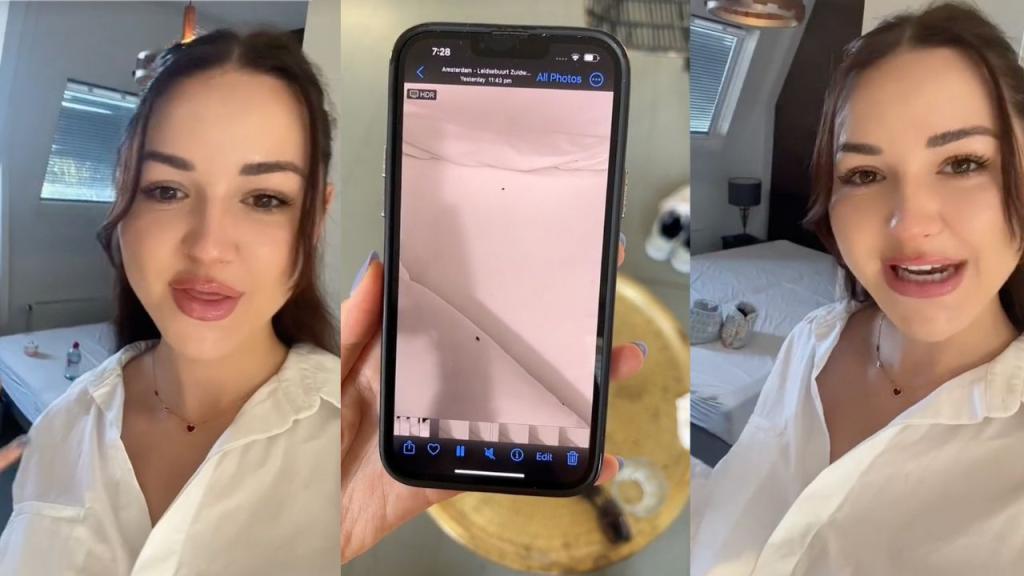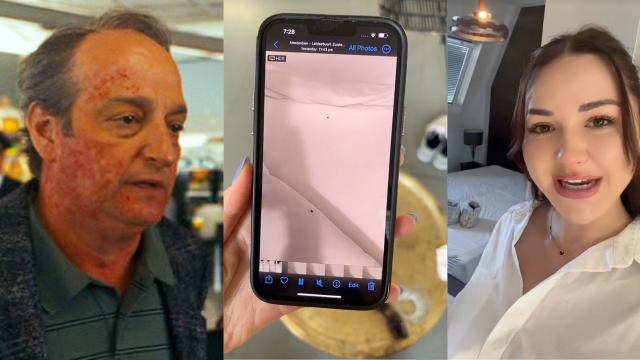“Sleep tight, don’t let the bed bugs bite” is a catchphrase we all love saying, but in reality, snoozing alongside bed bugs is something you wouldn’t wish upon your worst enemy.
Unfortunately, these nasty little critters can sometimes show up at hotels and Airbnbs, and they’re incredibly difficult to spot, so your first encounter with one (or an infestation) might be when you wake up with bites all over your body.
In fact, it was only when one of Australia’s most popular influencers shared her horrible bed bug experience while travelling through Europe that this kind of problem really crossed the minds of many Aussie travellers.
TikTok star Anna Paul was staying at an Airbnb with her family in Amsterdam when she found tiny bugs in the bed.
“When my mama lay down in bed last night, little bugs started crawling up her neck, crawling up her legs,” Paul said in her video, which over 4.3 million people have watched at the of writing.
The Gold Coast influencer then proceeded to show her fans videos of the insects crawling through the linen.
“Are you kidding me? Are you kidding me? There’s so many of them,” she squealed.
What’s worse, two days later, she commented on her video revealing the Airbnb host “ghosted” her after she alerted them to the issue.

So, how can you tell if your room is home to these creepy crawlies if you can’t always see them? Here are a few telltale signs to look out for.
The signs a room is home to bed bugs
Bites
If you can’t find any obvious signs of bed bugs in your room, the biggest sign of them is waking up to find itchy red bumps scattered over your body. They commonly appear in small clusters or zigzag lines of three to four bites but can also appear as single bites or in random patterns. They tend to feed in areas where bare skin is exposed during the night, so think arms, hands, shoulders and legs. Although not dangerous, some bites can become infected, according to Healthdirect. “Some people do not react, while others may not react until up to nine days after they are bitten,” the site reads.
“Very occasionally, people with multiple bites have lost so much blood they become anaemic. Some doctors believe bed bugs may trigger allergies and asthma.”
Book an appointment with your local GP if your bites look worse than expected.
A strange odour
As Better Health shares, a damp, musty odour like that of a wet towel or mouldy laundry can suggest bed bugs are present. This comes from a mix of unpleasant things — scent glands of live bugs, fecal matter and dead bugs decaying. It can be particularly present if there is a large amount of them living in a room.
Dark spots on walls
Bed bugs will excrete after feeding on the blood of humans and other animals. They’ll defecate on walls, mattresses, baseboards, linen and any surface they crawl across after feeding. According to Fantastic Pest Control, these marks will look like small black, red or brown spots about the size of a pen tip. They can be difficult to wash out from fabric, too. Water causes these stains to smear and can resemble marker stains.
Blood on sheets
If it’s not bug poop then there’s a good chance it’s bug blood because when these critters get squashed, they release a lot of blood. Plunkett’s Pest Control recommends checking the seams of the mattress or on pillowcases for signs of blood, as this is where bed bugs tend to hide.
“The space between your pillow and pillowcase makes a perfect daytime hiding spot, so it’s possible to crush them when you lie down and cause a small red stain on your pillow as well.”
Blood stains will turn a rusty colour the longer they have been there.
Shell casings
The Center for Disease Control and Prevention (U.S) says bed bugs go through five lifecycle stages before reaching adulthood, and during this period, they’ll shed their exoskeleton several times. So, spotting translucent, hollow husks is a sure sign of a growing bed bug infestation. These shell casings (also known as shed skins or husks) can be found anywhere that bed bugs hatch and breed.
Pearly white eggs
Eggs are a little harder to spot compared to shell casings, but they’re still visible to the naked eye. They are about one millimetre long, oval-shaped and pearly white, which resemble tiny grains of rice.
Female bed bugs can lay up to seven eggs per day, which hatch within 10 days. They’ll deposit them using a glue-like material that sticks to surfaces, so you’ll most likely find eggs stuck to crevices between fabrics or on wooden surfaces.

Leave a Reply
You must be logged in to post a comment.